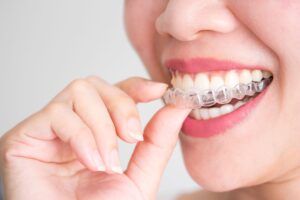
If you’re seeking a solution for crooked teeth but prefer to avoid metal brackets, Invisalign could be the answer. This alternative to traditional orthodontics uses clear plastic aligner trays that fit snugly over your pearly whites to reposition them, instead. Not only are they more visually discrete, but they’re also removable, so you won’t have to worry about any dietary restrictions.
Many patients wonder, however, whether it’s possible for them to get cavities during their treatment. After all, their teeth are covered, so shouldn’t they be protected? Continue reading to learn more about it so you can decide whether Invisalign is right for you!
Does Invisalign Protect My Teeth from Cavities?
There’s a common misperception that because Invisalign sits over your teeth it shields them from harm. While this might be somewhat true in some circumstances, like if you suffer from teeth grinding, it’s not true of tooth decay.
Cavities happen when harmful bacteria in your mouth work in tandem with acids from the foods you eat to erode your enamel. Because you don’t wear your trays while you’re eating, they won’t do anything to keep germs at bay. Then, when you reinsert them, you’ll trap any microbes or food particles against your teeth and gums for long periods. That means you’re at an increased risk of developing an issue, but thankfully, there are things you can do to prevent it.
What Happens If I Get a Cavity with Invisalign?
If you do develop a cavity during the course of your Invisalign treatment, your dentist will need to fix it. If it’s a simple cavity, they’ll apply a tooth-colored filling to keep bacteria out and restore your tooth’s functionality. If it’s become infected, you may need a root canal procedure. In that case, you’ll likely be fitted with a dental crown afterward to shield it afterward.
Once your tooth has been repaired, you might feel some tenderness or aching when you put your Invisalign back in. The aligners may have a slightly different fit due to minor changes after it’s been restored.
How Can I Prevent Cavities with Invisalign?
One of the simplest and most effective ways to safeguard your smile is to maintain a consistent at-home oral hygiene routine. You’ll wear your aligners for 22 hours every day, but it’s important to take them out at least twice every day to thoroughly scrub them along with your mouth. You should brush and floss thoroughly to remove any bacteria or plaque buildup from your teeth and gums. Then, to cleanse the trays, you can gently brush them with a soft-bristled toothbrush and gentle dish soap. You can also soak them in a solution with Invisalign Cleaning Crystals to eradicate up to 99% of unwanted germs.
While it is possible to get cavities with Invisalign, there’s plenty you can do to keep them at bay!
About the Practice
At Jacksonville Dental Specialists, patients benefit from the expertise of both a board-certified prosthodontist and a board-certified periodontist who work together to offer a full array of services. Whether you need basic preventative care, like a checkup and cleaning, or need a more complex procedure, they can help. They’ll create a fully individualized plan to help you meet your dental goals, including straightening your teeth with Invisalign. If you want to know whether it’s the right treatment for you, you can request a consultation on the website or by calling (904) 683-4781.
